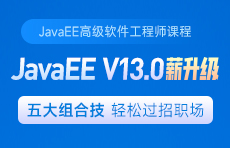什么是单向链表?怎样创建单向列表
更新时间:2023年03月03日11时36分 来源:传智教育 浏览次数:

在计算机科学中,链表是数据元素的线性集合,其每个元素都指向下一个元素,元素存储上并不连续。链表可以分为单向链表和双向链表。
单向链表,每个元素只知道其下一个元素是谁。
![]()
双向链表,每个元素知道其上一个元素和下一个元素。

循环链表,通常的链表尾节点 tail 指向的都是 null,而循环链表的 tail 指向的是头节点 head。链表内还有一种特殊的节点称为哨兵(Sentinel)节点,也叫做哑元( Dummy)节点,它不存储数据,通常用作头尾,用来简化边界判断。
单向链表
根据单向链表的定义,首先定义一个存储 value 和 next 指针的类 Node,和一个描述头部节点的引用。
public class SinglyLinkedList {
private Node head; // 头部节点
private static class Node { // 节点类
int value;
Node next;
public Node(int value, Node next) { this.value = value;
this.next = next;
}
}
}
在上述代码中Node 定义为内部类,是为了对外隐藏实现细节,没必要让类的使用者关心 Node 结构定义为 static 内部类,是因为 Node 不需要与 SinglyLinkedList 实例相关,多个 SinglyLinkedList实例能共用 Node 类定义。下面演示单向链表的创建方法
头部添加(头插法)
public class SinglyLinkedList {
// ...
public void addFirst(int value) {
this.head = new Node(value, this.head);
}
}
如果 this.head == null,新增节点指向 null,并作为新的 this.head。如果 this.head != null,新增节点指向原来的 this.head,并作为新的 this.head。注意赋值操作执行顺序是从右到左
尾部添加
public class SinglyLinkedList {
// ...
private Node findLast() {
if (this.head == null) {
return null;
}
Node curr;
for (curr = this.head; curr.next != null; ) {
curr = curr.next;
}
return curr;
}
public void addLast(int value) {
Node last = findLast();
if (last == null) {
addFirst(value);
return;
}
last.next = new Node(value, null);
}
}
注意,找最后一个节点,终止条件是 curr.next == null ,分成两个方法是为了代码清晰,而且 findLast() 之后还能复用。
尾部添加多个
public class SinglyLinkedList {
// ...
public void addLast(int first, int... rest) {
Node sublist = new Node(first, null);
Node curr = sublist;
for (int value : rest) {
curr.next = new Node(value, null);
curr = curr.next;
}
Node last = findLast();
if (last == null) {
this.head = sublist;
return;
}
last.next = sublist;
}
}
先串成一串 sublist,再作为一个整体添加。
根据索引获取
public class SinglyLinkedList {
// ...
private Node findNode(int index) {
int i = 0;
for (Node curr = this.head; curr != null; curr = curr.next, i++) {
if (index == i) {
return curr;
}
}
return null;
}
private IllegalArgumentException illegalIndex(int index) {
return new IllegalArgumentException(String.format("index [%d] 不合法%n", index));
}
public int get(int index) {
Node node = findNode(index);
if (node != null) {
return node.value;
}
throw illegalIndex(index);
}
}
同样,分方法可以实现复用
插入
public class SinglyLinkedList {
// ...
public void insert(int index, int value) {
if (index == 0) {
addFirst(value);
return;
}
Node prev = findNode(index - 1); // 找到上一个节点
if (prev == null) { // 找不到
throw illegalIndex(index);
}
prev.next = new Node(value, prev.next);
}
}
注意:插入包括下面的删除,都必须找到上一个节点。
删除
public class SinglyLinkedList {
// ...
public void remove(int index) {
if (index == 0) {
if (this.head != null) {
this.head = this.head.next;
return;
} else {
throw illegalIndex(index);
}
}
Node prev = findNode(index - 1);
Node curr;
if (prev != null && (curr = prev.next) != null) {
prev.next = curr.next;
} else {
throw illegalIndex(index);
}
}
}
第一个 if 块对应着 removeFirst 情况,最后一个 if 块对应着至少得两个节点的情况,不仅仅判断上一个节点非空,还要保证当前节点非空。


















 AI智能应用开发
AI智能应用开发 AI大模型开发(Python)
AI大模型开发(Python) AI鸿蒙开发
AI鸿蒙开发 AI嵌入式+机器人开发
AI嵌入式+机器人开发 AI大数据开发
AI大数据开发  AI运维
AI运维 AI测试
AI测试 跨境电商运营
跨境电商运营 AI设计
AI设计 AI视频创作与直播运营
AI视频创作与直播运营 微短剧拍摄剪辑
微短剧拍摄剪辑 C/C++
C/C++ 狂野架构师
狂野架构师





















